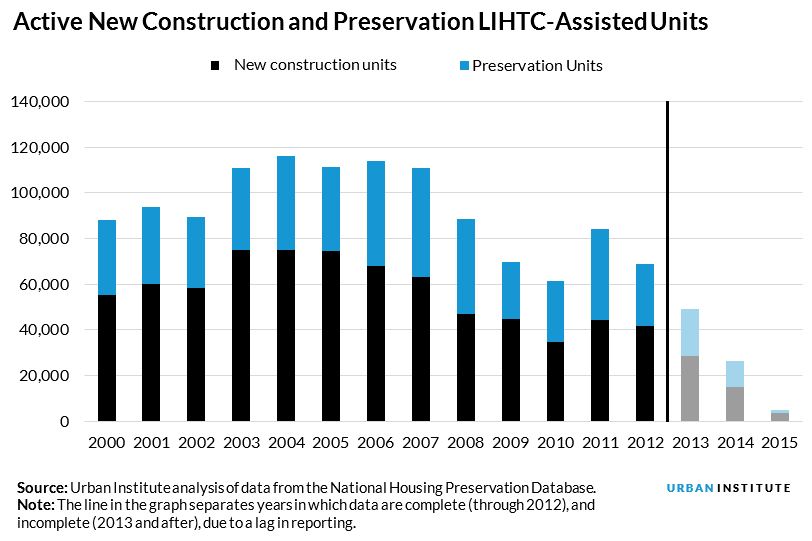
<p>Illustration by Rupert King/Getty Images.</p>
References to the Tax Cut and Jobs Act in this post have been corrected to the Tax Cuts and Jobs Act. (Updated 07/16/19).
Recent headlines have focused on US Department of Housing and Urban Development (HUD) secretary Ben Carson’s proposal to raise rents for low-income households who receive public housing assistance. But less attention has been paid to a federal program instrumental in producing and preserving affordable rental housing and whose effectiveness could be blunted by the 2017 Tax Cuts and Jobs Act (TCJA).
The Low-Income Housing Tax Credit (LIHTC) program is the longest-running federal program for building new affordable rental housing units and preserving older units built under other federal housing assistance programs. Based on our new analysis of the National Housing Preservation Database, we determine that LIHTC has produced or preserved roughly 2.3 million unique units of affordable housing for eligible low-income households since 1987.
But as we explore in the analysis, the LIHTC program is vulnerable to market downturns and changes in the tax code because it provides financing to developers through a federal income tax credit to private investors.
The TCJA slashed the corporate tax rate to 21 percent, decreasing financial incentives for corporations—the largest LIHTC investors—to make equity investments in tax credits. Historically, LIHTC has performed poorly when investment interest wanes, and industry sources have estimated that LIHTC production could decline by 235,000 units over the next 10 years.
A temporary increase in the amount of available LIHTC credits in the March 2018 omnibus appropriations bill—12.5 percent for the next four years—might help more projects access financing, but the ability of any funded project to raise the full equity investment needed is uncertain.
As rents rise and incomes stagnate, changes in the LIHTC program’s production could have serious consequences for communities dependent on it for their supply of affordable rentals.
Why LIHTC is crucial for affordable housing
LIHTC fills a widening gap between rents and incomes by providing direct incentives through the tax code for private investment in affordable housing. The national supply of affordable rental units lags behind demand, leaving few units available for households with below-average incomes.
Although rental construction has picked up since the Great Recession, much of this development has targeted high-end luxury units affordable only to high-income households. Median incomes have been increasing, but so have rents, meaning nearly half of renters spend more than 30 percent of their income on rent.
LIHTC is critical for preserving and expanding the existing affordable housing stock, particularly because funding for new units through other federal assistance programs such as public housing and project-based Section 8 (property-specific rental assistance to landlords and tenants) has either ended or dropped significantly over the past several decades.
LIHTC is also popular. The program typically enjoys bipartisan support, and it is backed by both affordable housing advocates and the homebuilding industry. LIHTC transactions also benefit a network of partners, including owners and developers, equity investors, state and local governments, and tenants.
LIHTC is vulnerable to market downturns
Despite broad support, LIHTC investments faltered during the Great Recession. Investor demand for tax credits dried up. The average amount of equity an investor was willing to pay for each dollar of tax credit written off their federal income tax dropped to a 15-year low.
Deals collapsed for tens of thousands of units in projects that won a tax credit allocation in 2007 or 2008 but were unable to attract private investment. Annual production and preservation investments plummeted 47 percent from a prerecession peak of 116,175 units in 2004 to a low of 61,400 units in 2010.

The federal government authorized two programs to offset declining investments during the Great Recession. The Tax Credit Assistance Program, run by HUD, provided an additional $2.25 billion to state housing finance agencies to fill funding gaps in projects that already won a LITHC allocation but whose investors might have pulled out during the recession.
The Tax Credit Exchange Program allowed state housing finance agencies to exchange unused tax credits from 2007 to 2009 for a grant from the US Treasury. These programs helped fund 1,770 projects with up to 135,000 new low-income rental units (some units may have received funding from both sources and would be counted twice).
Although neither program is financing new units today, all the units they placed in service are still within the 30-year affordability period. Even with this support, LIHTC production has not recovered to prerecession levels, based on available data.
What the future might hold for LIHTC
LIHTC is central to the preservation and production of affordable rental housing, but it was absent from TCJA considerations and has faced other threats under various Trump administration budget proposals. It has struggled to attract private investment during prior periods of investor uncertainty and will continue to do so. We need long-term solutions for LIHTC focused on answering key questions:
- How will the TCJA affect LIHTC? How does this vary across different housing markets and geographies?
- How dependent is LIHTC on other federal funding streams, including capital development and rental assistance programs? How can this inform the distribution of federal resources to most efficiently support LIHTC properties?
As affordable rental housing shortfalls deepen, we need to monitor the impact of tax reform on the LIHTC market. It is unclear whether the administration will address the projected shortfall of affordable housing produced or preserved by LIHTC. Should this critical social safety net program falter, we will need creative solutions to keep the production and preservation of affordable rental housing going.
Let’s build a future where everyone, everywhere has the opportunity and power to thrive
Urban is more determined than ever to partner with changemakers to unlock opportunities that give people across the country a fair shot at reaching their fullest potential. Invest in Urban to power this type of work.